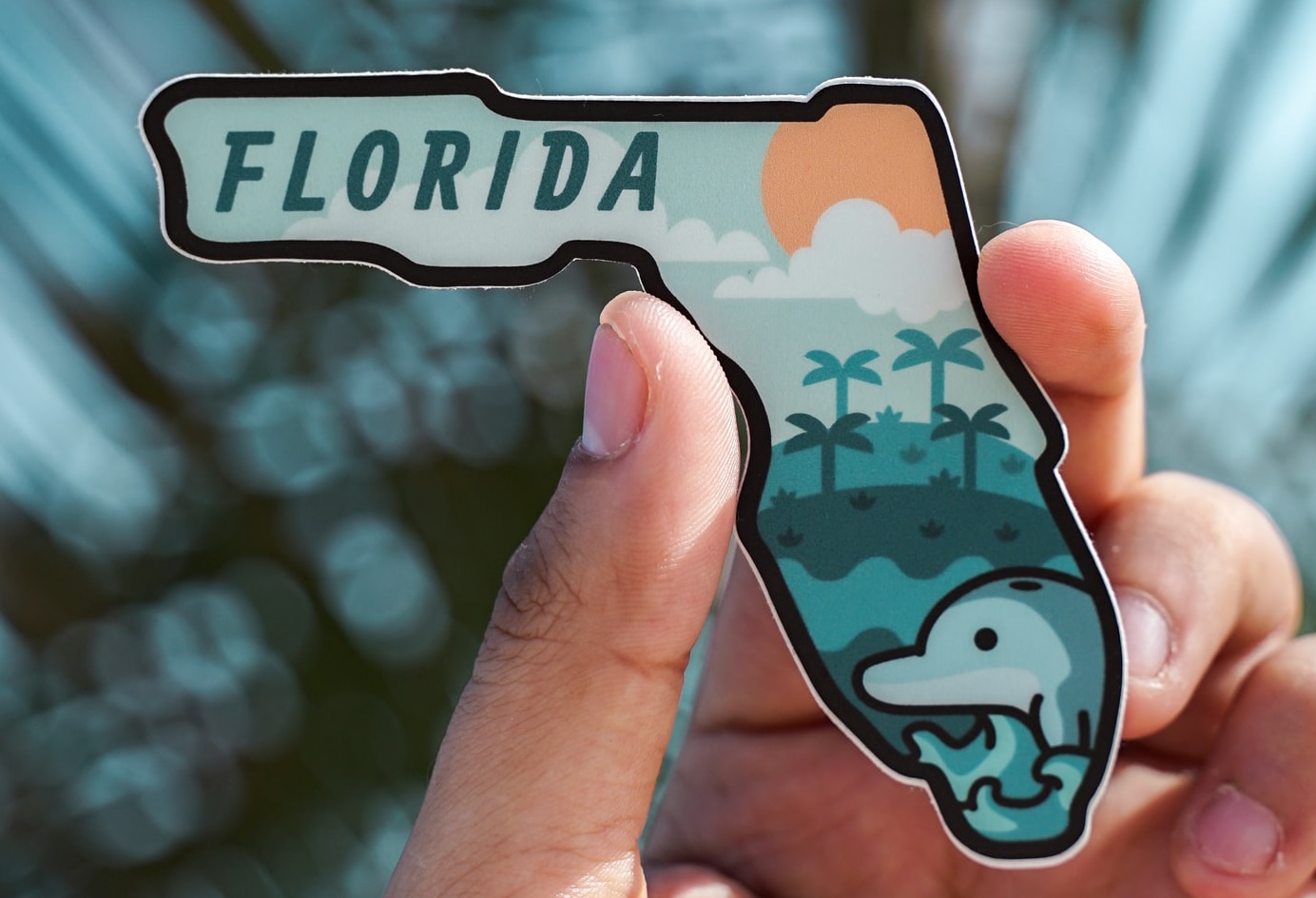Florida has always been a go-to state, but new driver’s license registrations finds a notable increase during the pandemic – a major reason for rising rental prices.
WEST PALM BEACH, Fla. – Extraordinary events have forever pushed and pulled and pressured U.S. population shifts, from gold lust to the citrus rush to the restless return of WWII soldiers to revolutions in foreign lands and civil war on southern soil.
Now there is COVID-19, which has turned a years-long trickle to Florida from the northeast into a deluge. More than 547,000 people exchanged out-of-state driver’s licenses last year for ones with Sunshine State addresses. That’s a 40% increase from 2020 and nearly 20% greater than the five-year average between 2017 and 2021.
The license swaps – largely from New York (11%), New Jersey (6%) and foreign countries (14%) – are acutely felt in Florida real estate markets where inventory is anemic and prices aggressive. The median sale price on Palm Beach County single-family homes ended 2021 at nearly half-a-million dollars with the average price pushing seven figures.
Demographers believe the relocations are no tropical dalliance because a driver’s license switch is a sign of determination to make Florida home, even if hurricane season and August’s sweltering humidity are spent in cooler climes away from storms and sticky air.
“Unquestionably the COVID impact was the trigger,” said Related Cos. President Ken Himmel about the influx of people and businesses to Florida and Palm Beach County specifically. “Unquestionably, COVID turned the switch on full blast.”
While the bullseye markets, such as Palm Beach County, may experience the ache of rising rents and home prices until inventory increases, growth experts were reluctant to say the COVID migration on a nationwide scale will make history. Some move to the suburbs was already happening as millennials age. A bump in retirees was also expected, although it was likely expedited by the Great Resignation/Retirement, the euphemism signaling massive waves of frustrated workers and Baby Boomers exiting the job market. Vanderbilt University Assistant Finance Professor Peter Haslag said COVID-related dispersions are more geographically diverse than past migrations, diluting long-term impacts.
For Florida, migration is tradition.
“Migration to Florida is an old story,” said University of Washington professor and historian James Gregory in an article for America’s Great Migrations Project that noted the early 1900s citrus and land boom in the state. “More than any other state, Florida has consistently attracted newcomers.”
Of the 61,728 New Yorkers who in 2021 handed over Empire State driver’s licenses for a Florida license, 19,100 or 31% got IDs with Broward, Miami-Dade or Palm Beach County Zip codes. Palm Beach County accounted for 8,107 of the transplants, the largest share of any county in the state.
Outside of the Gold Coast counties of southeast Florida, a weighty exchange of New York licenses last year also occurred in Orange (4,203), Hillsborough (3,746), Lee (2,672), Pinellas (2,335) and Sarasota (2,149) counties.
For native New Yorker Sandford Burian, 59, the reward for his 90-minute commute into the city from Long Island was the entertainment – a ball game or show – a nice dinner and a “zillion corporate events” to partake in after work. With COVID restrictions shutting down much of the city and most people working from home, the recompense for the daily slog into Manhattan was gone, he said.
Burian and his wife Heidi, 58, recently bought a home in the Avenir community in Palm Beach Gardens and plan to become Florida residents.
“Maybe you were coming home late but there were these big, unique experiences you had every day in the city,” said Burian, who is renting a home in West Palm Beach until the Avenir residence is finished this summer. “None of that exists now. It makes the tolerance for the commute even harder.”
When Burian’s job as a management and technology consultant went remote, Florida’s better weather and tax benefits beckoned. The pushback from younger employees about returning to offices full time made Burian dubious about what the future holds for New York City.
“We saw how much the pandemic devastated New York City and I’m not sure I want to be around for the recovery or for how long that recovery will take,” he said. “Unless the working model literally reverted back to what it was traditionally where everyone had to be in the office every day, I don’t think people are going back.”
It’s no surprise Palm Beach County attracted a heavy influx from the northeast, business leaders said. The Business Development Board of Palm Beach County started courting New York companies in earnest a decade ago – a pursuit that picked up “great momentum” after the pandemic, said BDB President Kelly Smallridge in an email. She ticked off a list of 2020-2021 corporate newcomers that includes financial services provider Virtu Financial, insurance broker NFP, Point72 Asset Management, hedge fund Elliott Management Corp., the Goldman Sachs Group, Millennium Asset Management and asset management firm Benefit Street Partners.
In early 2021, the Partnership for New York City sent a letter to New York state lawmakers warning that 300,000 city residents of “higher income neighborhoods” had filed for a change of address with the U.S. Postal Service and that Florida, Texas, North Carolina and Maryland were aggressively pursuing New York companies.
“The top 5% of earners pay 62% of state personal income taxes,” the letter said. “These high earners do not want to abandon New York, but at some point, it does not make sense to stay where the business climate is deteriorating and costs are rising.”
After selling a home in Darien, Conn., and moving full time to a second home in the Hamptons, Tom and Cricket Cush decided Florida was where they wanted to settle. While the beaches and sunshine are a main attraction, Tom said he feels the “spirit and attitude” in Florida during COVID has been more optimistic than in New York.
“It’s a glass is half full feeling,” said Cush, who is building a home in West Palm Beach. “I will tell you as a born and bred New Yorker, coming down here, it feels liberating.”
He echoed Burian’s lament of the long commute into the New York but said it was something he did for more than two decades because that’s what everyone did and other options were limited.
“The pandemic changed that perspective for a lot of people,” he said.
West Palm Beach fit for the couple because they enjoy boating and it has cosmopolitan amenities such as the Norton Museum of Art, tony restaurants and a busy downtown. The things they enjoyed doing, they can still relish “with the added advantage of the weather,” Cush said.
As popular as Palm Beach County was last year, Miami-Dade County took the top spot for the most license swaps with 48,266. Of those, half were from “foreign countries.” Following Miami-Dade County were Hillsborough (36,626), Orange (35,582), Broward (34,084), and Palm Beach (33,859).
Jeff Lichtenstein, owner and broker of Echo Fine Properties, which helped Burian find a home in Avenir, said competition from transplants means new communities are getting myriad reservations on homes before ground is even broken.
“The strategies a buyer has to go through now are just insane,” he said. “We’re figuring out on the front end what the seller wants, what the agent wants when we write offers. We’re pre-booking inspections, filling out all the forms and doing all the things they are going to ask for.”
Haslag, the Vanderbilt University professor, released a study in October titled “From L.A. to Boise: How Migration has Changed during the COVID-19 Pandemic.” Boise, Idaho’s state capital city, has consistently ranked over the past year as the most overvalued housing market in the nation as remote workers flocked to an area revered for its outdoor activities and considered one of the “best cities to raise a family.”
Haslag said a permanent change in peoples’ lifestyle preferences has occurred and that the shifts in populations are unlikely to reverse in the near future.
“I don’t have anyone calling me saying they want to move back to New York,” said Douglas Elliman Realtor Joseph Wagner, who spent most of the pandemic in Florida and is licensed in Florida and New York. “Some people miss it, but most of them just want to have a spare bedroom in New York and live in Florida.”
Wagner said that while buyers know they aren’t getting a deal with their Florida real estate purchases, it’s still cheaper than buying and living in New York.
“It’s a seller’s market. They don’t care,” he said. “They just don’t want to pay New York state taxes.” Wagner was reluctant to share names of his New York clients.
View this post on Instagram
In early January, letters asking “woke” New Yorkers to leave Florida were put on cars in Palm Beach that had New York license plates. The notices – written in capital letters – read: “If you are one of the those ‘woke’ people – leave Florida. You will be happier elsewhere, as will we.”
Chris Porter, chief demographer at John Burns Real Estate Consulting, said he’s heard anecdotally on a national level some tension between locals and newcomers, but it’s been focused on the increasing prices, not politics.
Cush said he’s felt no tension. He said he was careful to tell his new neighbors about the plans for the property he bought and said he hopes long-time residents are patient with the changes.
“Maybe they’ll even appreciate it a little that their property values will go up,” Cush said.
Top 10 heading to Florida
Foreign countries made up the largest license exchanges in Florida last year with 46,370. That was followed by New York’s 42,224 and New Jersey’s 32,083.
Statewide, California ranked fourth highest in the number of driver’s license exchanges in 2021 with 27,081 – a notable 43% higher than the 5-year average and 55% higher than 2020.
Illinois, Pennsylvania, Georgia, Texas, Ohio and Virginia rounded out the top 10 of most license swaps. All were higher than the 5-year average.
Nearly 1,900 of the 2021 California changes were made to Palm Beach County addresses. While that’s small compared to the number from the northeast, it’s 51% higher than the 5-year average and 63% higher than 2020.
New York transplant Burian said despite the dispersed migration nationwide, he believes South Florida will feel a profound impact from the northeast newcomers who may have different – if not more expensive – demands and bigger checkbooks for donations to the arts and charities.
“I think a lot of affluence is coming down here and the heavy hitters are moving down and the qualitative demands of these people are huge,” Burian said. “The question is what’s going to happen to New York.”
© Copyright 2022 The Palm Beach Post, Kimberly Miller



